Cognitive Psychology Report: Investigating Gender and Simon Effect
VerifiedAdded on 2021/04/21
|15
|2580
|91
Report
AI Summary
This report presents a study investigating gender differences in the Simon Effect, a cognitive phenomenon where reaction time is influenced by the spatial relationship between a stimulus and a response. The study employed a 2x2 within-participant design, comparing congruent and incongruent response times between male and female participants. A sample of 150 participants was used, with equal representation from both genders. The study aimed to determine if females were more susceptible to the Simon Effect. Data analysis involved a two-way ANOVA test. The results indicated no significant relationship between gender and congruence, leading to the rejection of the hypothesis that females are more prone to the Simon Effect. The study's findings are discussed in relation to existing literature, highlighting consistencies and contradictions. The report includes details on the methodology, results, and statistical analysis, along with limitations and references. The study concludes that while the Simon Effect is evident, it does not appear to be significantly influenced by gender.

Running Head: COGNITIVE PSYCHOLOGY
Gender and Simon Effect
Name of the Student
Name of the University
Author Note
Gender and Simon Effect
Name of the Student
Name of the University
Author Note
Paraphrase This Document
Need a fresh take? Get an instant paraphrase of this document with our AI Paraphraser

1COGNITIVE PSYCHOLOGY
Abstract
The main interest of this study was to test whether females were more prone to Simon effect or
not. A 2 x 2 design was developed to conduct a study within participant. An equal number of
male and female members were selected for the study. A sample of 150 participants were
considered for the study of which there were 75 male and 75 female participants. The congruent
and incongruent response time scores were recorded for each of the individuals and a two sample
ANOVA test was conducted to test the effects of gender on congruence. The results stated that
there is no significant relationship between gender and congruence and hence Females are not
more prone to Simon effect than men.
Abstract
The main interest of this study was to test whether females were more prone to Simon effect or
not. A 2 x 2 design was developed to conduct a study within participant. An equal number of
male and female members were selected for the study. A sample of 150 participants were
considered for the study of which there were 75 male and 75 female participants. The congruent
and incongruent response time scores were recorded for each of the individuals and a two sample
ANOVA test was conducted to test the effects of gender on congruence. The results stated that
there is no significant relationship between gender and congruence and hence Females are not
more prone to Simon effect than men.
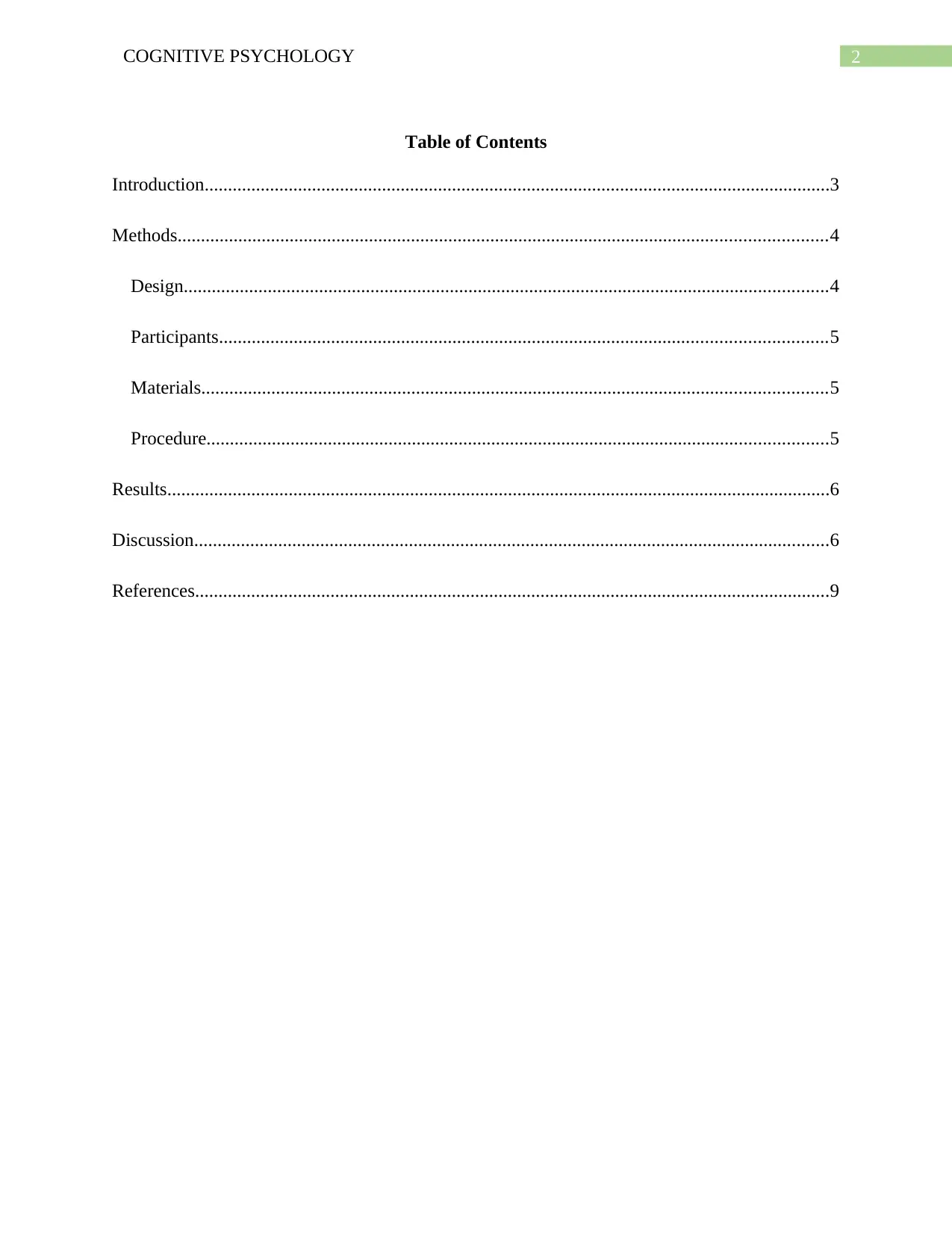
2COGNITIVE PSYCHOLOGY
Table of Contents
Introduction......................................................................................................................................3
Methods...........................................................................................................................................4
Design..........................................................................................................................................4
Participants..................................................................................................................................5
Materials......................................................................................................................................5
Procedure.....................................................................................................................................5
Results..............................................................................................................................................6
Discussion........................................................................................................................................6
References........................................................................................................................................9
Table of Contents
Introduction......................................................................................................................................3
Methods...........................................................................................................................................4
Design..........................................................................................................................................4
Participants..................................................................................................................................5
Materials......................................................................................................................................5
Procedure.....................................................................................................................................5
Results..............................................................................................................................................6
Discussion........................................................................................................................................6
References........................................................................................................................................9
⊘ This is a preview!⊘
Do you want full access?
Subscribe today to unlock all pages.

Trusted by 1+ million students worldwide
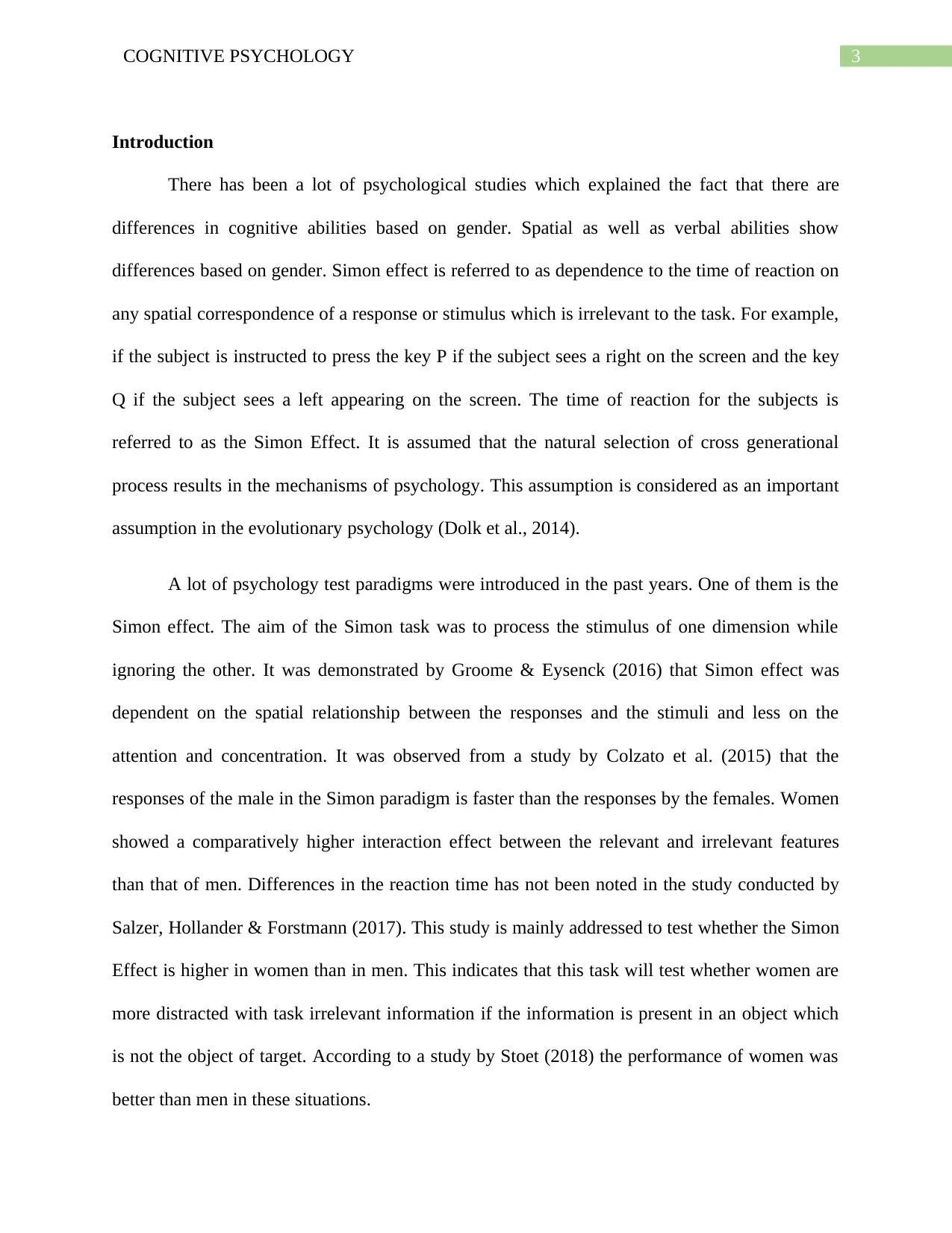
3COGNITIVE PSYCHOLOGY
Introduction
There has been a lot of psychological studies which explained the fact that there are
differences in cognitive abilities based on gender. Spatial as well as verbal abilities show
differences based on gender. Simon effect is referred to as dependence to the time of reaction on
any spatial correspondence of a response or stimulus which is irrelevant to the task. For example,
if the subject is instructed to press the key P if the subject sees a right on the screen and the key
Q if the subject sees a left appearing on the screen. The time of reaction for the subjects is
referred to as the Simon Effect. It is assumed that the natural selection of cross generational
process results in the mechanisms of psychology. This assumption is considered as an important
assumption in the evolutionary psychology (Dolk et al., 2014).
A lot of psychology test paradigms were introduced in the past years. One of them is the
Simon effect. The aim of the Simon task was to process the stimulus of one dimension while
ignoring the other. It was demonstrated by Groome & Eysenck (2016) that Simon effect was
dependent on the spatial relationship between the responses and the stimuli and less on the
attention and concentration. It was observed from a study by Colzato et al. (2015) that the
responses of the male in the Simon paradigm is faster than the responses by the females. Women
showed a comparatively higher interaction effect between the relevant and irrelevant features
than that of men. Differences in the reaction time has not been noted in the study conducted by
Salzer, Hollander & Forstmann (2017). This study is mainly addressed to test whether the Simon
Effect is higher in women than in men. This indicates that this task will test whether women are
more distracted with task irrelevant information if the information is present in an object which
is not the object of target. According to a study by Stoet (2018) the performance of women was
better than men in these situations.
Introduction
There has been a lot of psychological studies which explained the fact that there are
differences in cognitive abilities based on gender. Spatial as well as verbal abilities show
differences based on gender. Simon effect is referred to as dependence to the time of reaction on
any spatial correspondence of a response or stimulus which is irrelevant to the task. For example,
if the subject is instructed to press the key P if the subject sees a right on the screen and the key
Q if the subject sees a left appearing on the screen. The time of reaction for the subjects is
referred to as the Simon Effect. It is assumed that the natural selection of cross generational
process results in the mechanisms of psychology. This assumption is considered as an important
assumption in the evolutionary psychology (Dolk et al., 2014).
A lot of psychology test paradigms were introduced in the past years. One of them is the
Simon effect. The aim of the Simon task was to process the stimulus of one dimension while
ignoring the other. It was demonstrated by Groome & Eysenck (2016) that Simon effect was
dependent on the spatial relationship between the responses and the stimuli and less on the
attention and concentration. It was observed from a study by Colzato et al. (2015) that the
responses of the male in the Simon paradigm is faster than the responses by the females. Women
showed a comparatively higher interaction effect between the relevant and irrelevant features
than that of men. Differences in the reaction time has not been noted in the study conducted by
Salzer, Hollander & Forstmann (2017). This study is mainly addressed to test whether the Simon
Effect is higher in women than in men. This indicates that this task will test whether women are
more distracted with task irrelevant information if the information is present in an object which
is not the object of target. According to a study by Stoet (2018) the performance of women was
better than men in these situations.
Paraphrase This Document
Need a fresh take? Get an instant paraphrase of this document with our AI Paraphraser
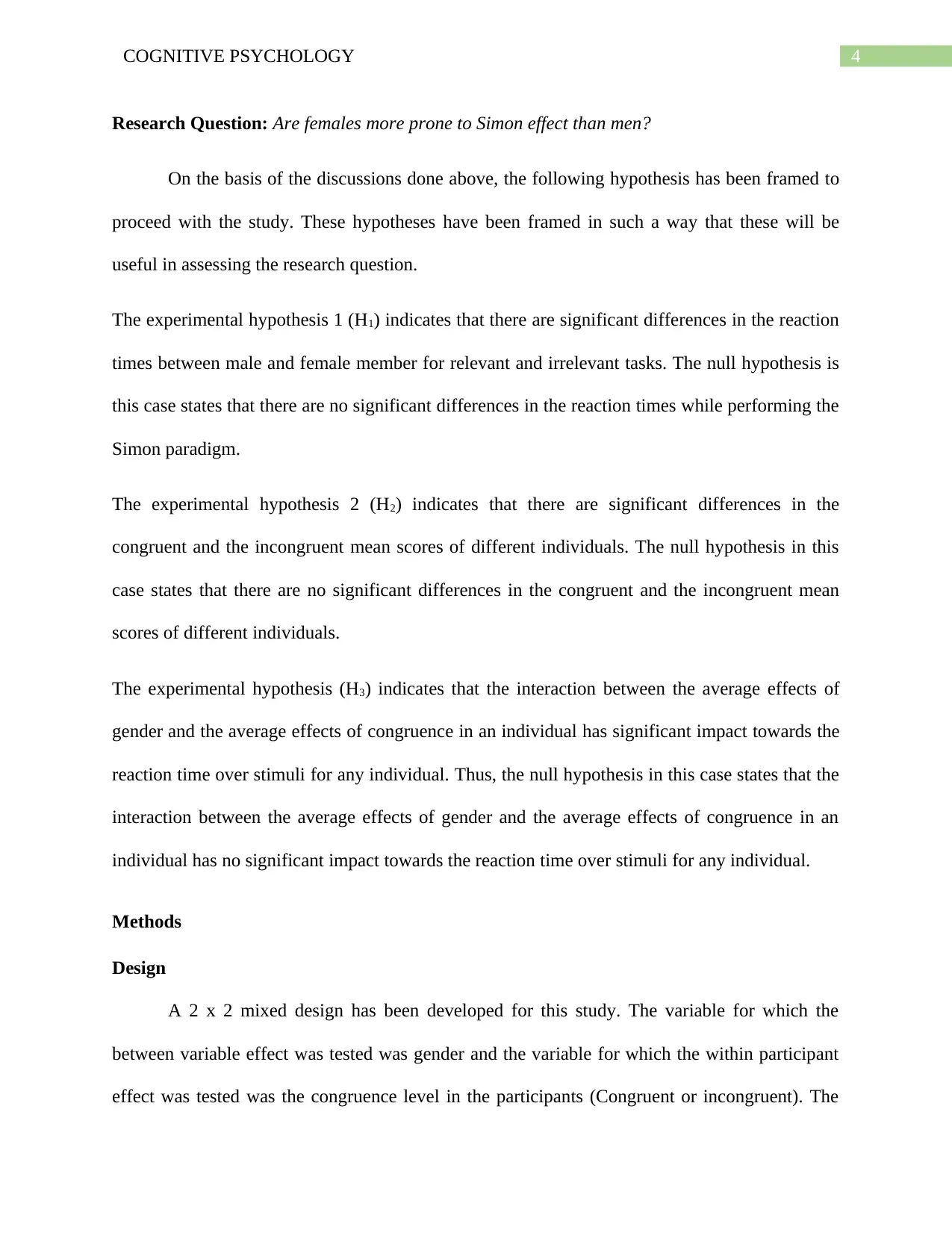
4COGNITIVE PSYCHOLOGY
Research Question: Are females more prone to Simon effect than men?
On the basis of the discussions done above, the following hypothesis has been framed to
proceed with the study. These hypotheses have been framed in such a way that these will be
useful in assessing the research question.
The experimental hypothesis 1 (H1) indicates that there are significant differences in the reaction
times between male and female member for relevant and irrelevant tasks. The null hypothesis is
this case states that there are no significant differences in the reaction times while performing the
Simon paradigm.
The experimental hypothesis 2 (H2) indicates that there are significant differences in the
congruent and the incongruent mean scores of different individuals. The null hypothesis in this
case states that there are no significant differences in the congruent and the incongruent mean
scores of different individuals.
The experimental hypothesis (H3) indicates that the interaction between the average effects of
gender and the average effects of congruence in an individual has significant impact towards the
reaction time over stimuli for any individual. Thus, the null hypothesis in this case states that the
interaction between the average effects of gender and the average effects of congruence in an
individual has no significant impact towards the reaction time over stimuli for any individual.
Methods
Design
A 2 x 2 mixed design has been developed for this study. The variable for which the
between variable effect was tested was gender and the variable for which the within participant
effect was tested was the congruence level in the participants (Congruent or incongruent). The
Research Question: Are females more prone to Simon effect than men?
On the basis of the discussions done above, the following hypothesis has been framed to
proceed with the study. These hypotheses have been framed in such a way that these will be
useful in assessing the research question.
The experimental hypothesis 1 (H1) indicates that there are significant differences in the reaction
times between male and female member for relevant and irrelevant tasks. The null hypothesis is
this case states that there are no significant differences in the reaction times while performing the
Simon paradigm.
The experimental hypothesis 2 (H2) indicates that there are significant differences in the
congruent and the incongruent mean scores of different individuals. The null hypothesis in this
case states that there are no significant differences in the congruent and the incongruent mean
scores of different individuals.
The experimental hypothesis (H3) indicates that the interaction between the average effects of
gender and the average effects of congruence in an individual has significant impact towards the
reaction time over stimuli for any individual. Thus, the null hypothesis in this case states that the
interaction between the average effects of gender and the average effects of congruence in an
individual has no significant impact towards the reaction time over stimuli for any individual.
Methods
Design
A 2 x 2 mixed design has been developed for this study. The variable for which the
between variable effect was tested was gender and the variable for which the within participant
effect was tested was the congruence level in the participants (Congruent or incongruent). The
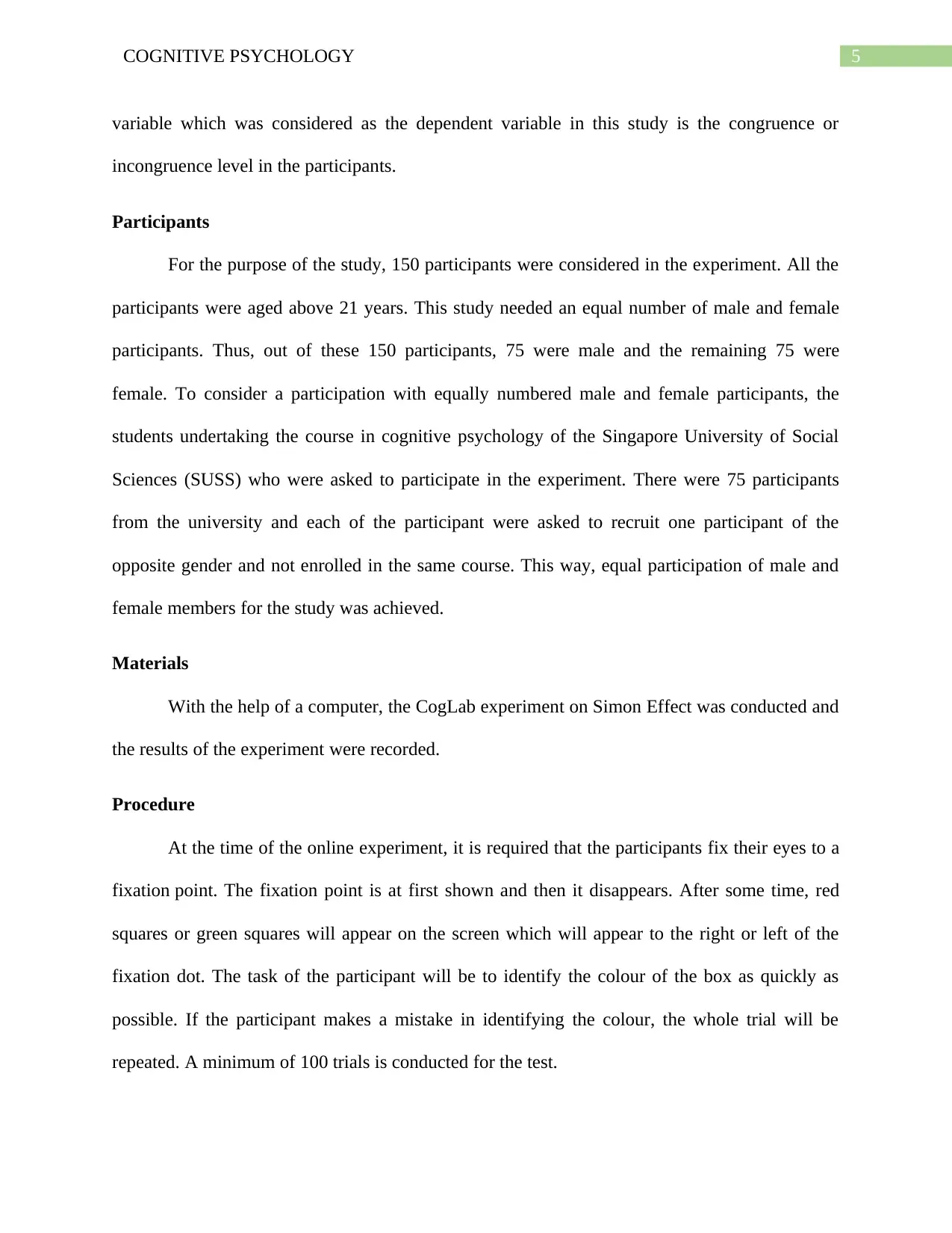
5COGNITIVE PSYCHOLOGY
variable which was considered as the dependent variable in this study is the congruence or
incongruence level in the participants.
Participants
For the purpose of the study, 150 participants were considered in the experiment. All the
participants were aged above 21 years. This study needed an equal number of male and female
participants. Thus, out of these 150 participants, 75 were male and the remaining 75 were
female. To consider a participation with equally numbered male and female participants, the
students undertaking the course in cognitive psychology of the Singapore University of Social
Sciences (SUSS) who were asked to participate in the experiment. There were 75 participants
from the university and each of the participant were asked to recruit one participant of the
opposite gender and not enrolled in the same course. This way, equal participation of male and
female members for the study was achieved.
Materials
With the help of a computer, the CogLab experiment on Simon Effect was conducted and
the results of the experiment were recorded.
Procedure
At the time of the online experiment, it is required that the participants fix their eyes to a
fixation point. The fixation point is at first shown and then it disappears. After some time, red
squares or green squares will appear on the screen which will appear to the right or left of the
fixation dot. The task of the participant will be to identify the colour of the box as quickly as
possible. If the participant makes a mistake in identifying the colour, the whole trial will be
repeated. A minimum of 100 trials is conducted for the test.
variable which was considered as the dependent variable in this study is the congruence or
incongruence level in the participants.
Participants
For the purpose of the study, 150 participants were considered in the experiment. All the
participants were aged above 21 years. This study needed an equal number of male and female
participants. Thus, out of these 150 participants, 75 were male and the remaining 75 were
female. To consider a participation with equally numbered male and female participants, the
students undertaking the course in cognitive psychology of the Singapore University of Social
Sciences (SUSS) who were asked to participate in the experiment. There were 75 participants
from the university and each of the participant were asked to recruit one participant of the
opposite gender and not enrolled in the same course. This way, equal participation of male and
female members for the study was achieved.
Materials
With the help of a computer, the CogLab experiment on Simon Effect was conducted and
the results of the experiment were recorded.
Procedure
At the time of the online experiment, it is required that the participants fix their eyes to a
fixation point. The fixation point is at first shown and then it disappears. After some time, red
squares or green squares will appear on the screen which will appear to the right or left of the
fixation dot. The task of the participant will be to identify the colour of the box as quickly as
possible. If the participant makes a mistake in identifying the colour, the whole trial will be
repeated. A minimum of 100 trials is conducted for the test.
⊘ This is a preview!⊘
Do you want full access?
Subscribe today to unlock all pages.

Trusted by 1+ million students worldwide

6COGNITIVE PSYCHOLOGY
Results
It has been observed from the results of the experiment that the mean score for both the
congruent and the incongruent reactions in males is less than that of females. Moreover, it can be
seen that the mean scores of overall congruence are higher in females than in males. The average
of these results of the experimental output is presented in table 1.
Table 1: Average score for congruent and incongruent reactions
Gender Mean
Male Female
Congruence Congruent 644 689 667
Incongruent 694 753 724
Mean 669 721
To test whether there are any main effects of gender on the congruence scores for each of
the participants, a two-way analysis of variance (ANOVA) test has been conducted. The results
of the ANOVA test are attached in the appendix section. It can be seen from the tables that the
significance value for the between subject effect of gender is 0.310, which is higher than the
level of significance (0.05). Thus, the first experimental hypothesis is rejected and there is no
main effect of gender. Main effect of congruence has been observed where the p value is 0.000
which is less than the level of significance (0.05). Thus, the second experimental hypothesis has
been accepted. No interaction effect between gender and congruence have been observed as the
sig value (0.467) is higher than the level of significance (0.05). Thus, the third experimental
hypothesis has been rejected.
Discussion
The aim of this study was to test whether Simon effect is more in females than in males.
Three experimental hypothesis was framed to test this claim. The first hypothesis stated that
there is main effect of gender on the Simon effect. It has been observed from the results of the
Results
It has been observed from the results of the experiment that the mean score for both the
congruent and the incongruent reactions in males is less than that of females. Moreover, it can be
seen that the mean scores of overall congruence are higher in females than in males. The average
of these results of the experimental output is presented in table 1.
Table 1: Average score for congruent and incongruent reactions
Gender Mean
Male Female
Congruence Congruent 644 689 667
Incongruent 694 753 724
Mean 669 721
To test whether there are any main effects of gender on the congruence scores for each of
the participants, a two-way analysis of variance (ANOVA) test has been conducted. The results
of the ANOVA test are attached in the appendix section. It can be seen from the tables that the
significance value for the between subject effect of gender is 0.310, which is higher than the
level of significance (0.05). Thus, the first experimental hypothesis is rejected and there is no
main effect of gender. Main effect of congruence has been observed where the p value is 0.000
which is less than the level of significance (0.05). Thus, the second experimental hypothesis has
been accepted. No interaction effect between gender and congruence have been observed as the
sig value (0.467) is higher than the level of significance (0.05). Thus, the third experimental
hypothesis has been rejected.
Discussion
The aim of this study was to test whether Simon effect is more in females than in males.
Three experimental hypothesis was framed to test this claim. The first hypothesis stated that
there is main effect of gender on the Simon effect. It has been observed from the results of the
Paraphrase This Document
Need a fresh take? Get an instant paraphrase of this document with our AI Paraphraser
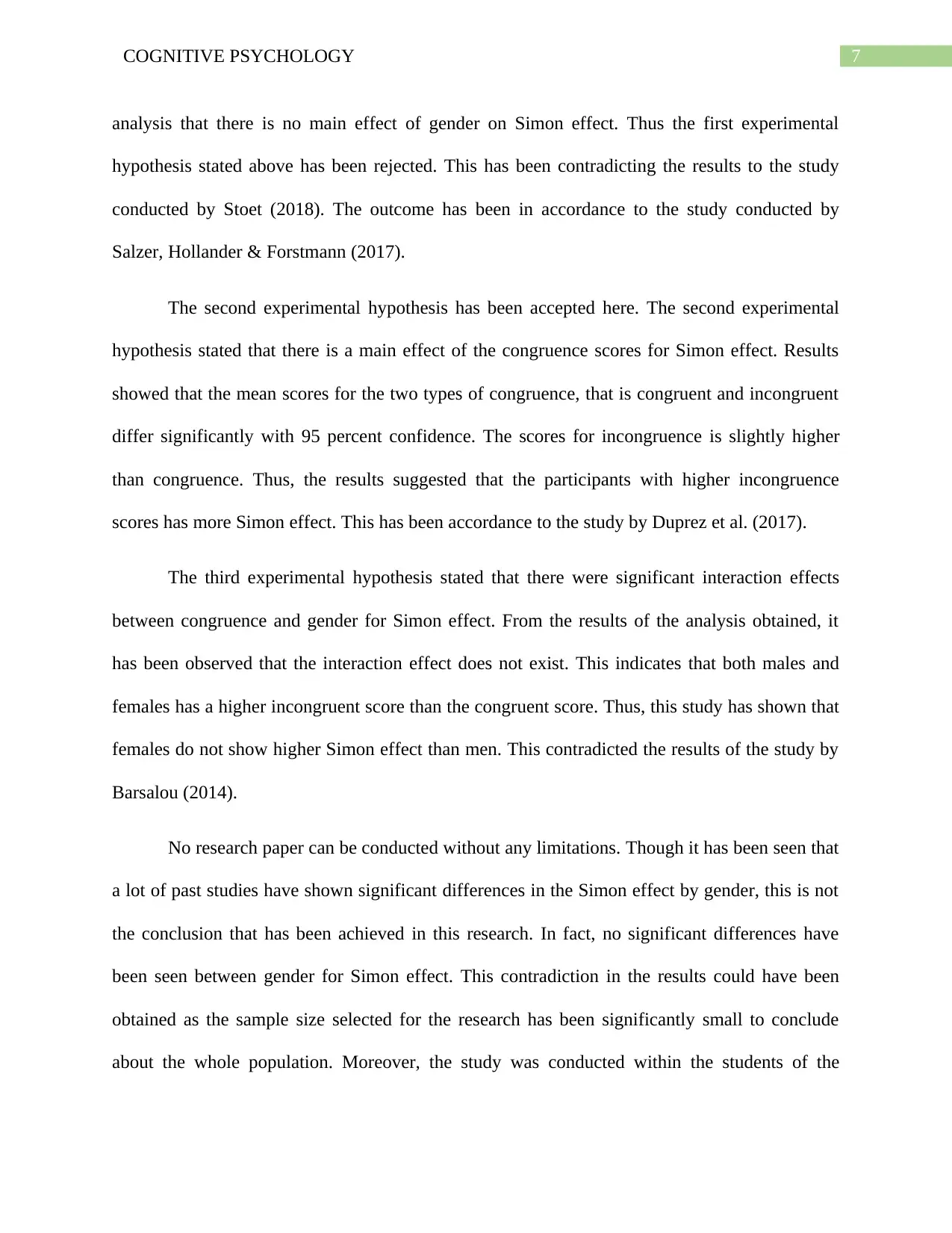
7COGNITIVE PSYCHOLOGY
analysis that there is no main effect of gender on Simon effect. Thus the first experimental
hypothesis stated above has been rejected. This has been contradicting the results to the study
conducted by Stoet (2018). The outcome has been in accordance to the study conducted by
Salzer, Hollander & Forstmann (2017).
The second experimental hypothesis has been accepted here. The second experimental
hypothesis stated that there is a main effect of the congruence scores for Simon effect. Results
showed that the mean scores for the two types of congruence, that is congruent and incongruent
differ significantly with 95 percent confidence. The scores for incongruence is slightly higher
than congruence. Thus, the results suggested that the participants with higher incongruence
scores has more Simon effect. This has been accordance to the study by Duprez et al. (2017).
The third experimental hypothesis stated that there were significant interaction effects
between congruence and gender for Simon effect. From the results of the analysis obtained, it
has been observed that the interaction effect does not exist. This indicates that both males and
females has a higher incongruent score than the congruent score. Thus, this study has shown that
females do not show higher Simon effect than men. This contradicted the results of the study by
Barsalou (2014).
No research paper can be conducted without any limitations. Though it has been seen that
a lot of past studies have shown significant differences in the Simon effect by gender, this is not
the conclusion that has been achieved in this research. In fact, no significant differences have
been seen between gender for Simon effect. This contradiction in the results could have been
obtained as the sample size selected for the research has been significantly small to conclude
about the whole population. Moreover, the study was conducted within the students of the
analysis that there is no main effect of gender on Simon effect. Thus the first experimental
hypothesis stated above has been rejected. This has been contradicting the results to the study
conducted by Stoet (2018). The outcome has been in accordance to the study conducted by
Salzer, Hollander & Forstmann (2017).
The second experimental hypothesis has been accepted here. The second experimental
hypothesis stated that there is a main effect of the congruence scores for Simon effect. Results
showed that the mean scores for the two types of congruence, that is congruent and incongruent
differ significantly with 95 percent confidence. The scores for incongruence is slightly higher
than congruence. Thus, the results suggested that the participants with higher incongruence
scores has more Simon effect. This has been accordance to the study by Duprez et al. (2017).
The third experimental hypothesis stated that there were significant interaction effects
between congruence and gender for Simon effect. From the results of the analysis obtained, it
has been observed that the interaction effect does not exist. This indicates that both males and
females has a higher incongruent score than the congruent score. Thus, this study has shown that
females do not show higher Simon effect than men. This contradicted the results of the study by
Barsalou (2014).
No research paper can be conducted without any limitations. Though it has been seen that
a lot of past studies have shown significant differences in the Simon effect by gender, this is not
the conclusion that has been achieved in this research. In fact, no significant differences have
been seen between gender for Simon effect. This contradiction in the results could have been
obtained as the sample size selected for the research has been significantly small to conclude
about the whole population. Moreover, the study was conducted within the students of the

8COGNITIVE PSYCHOLOGY
university and participants selected by them. Thus, the selection of the sample has also been
biased. If these limitations can be taken care of, the results can be altered.
university and participants selected by them. Thus, the selection of the sample has also been
biased. If these limitations can be taken care of, the results can be altered.
⊘ This is a preview!⊘
Do you want full access?
Subscribe today to unlock all pages.

Trusted by 1+ million students worldwide
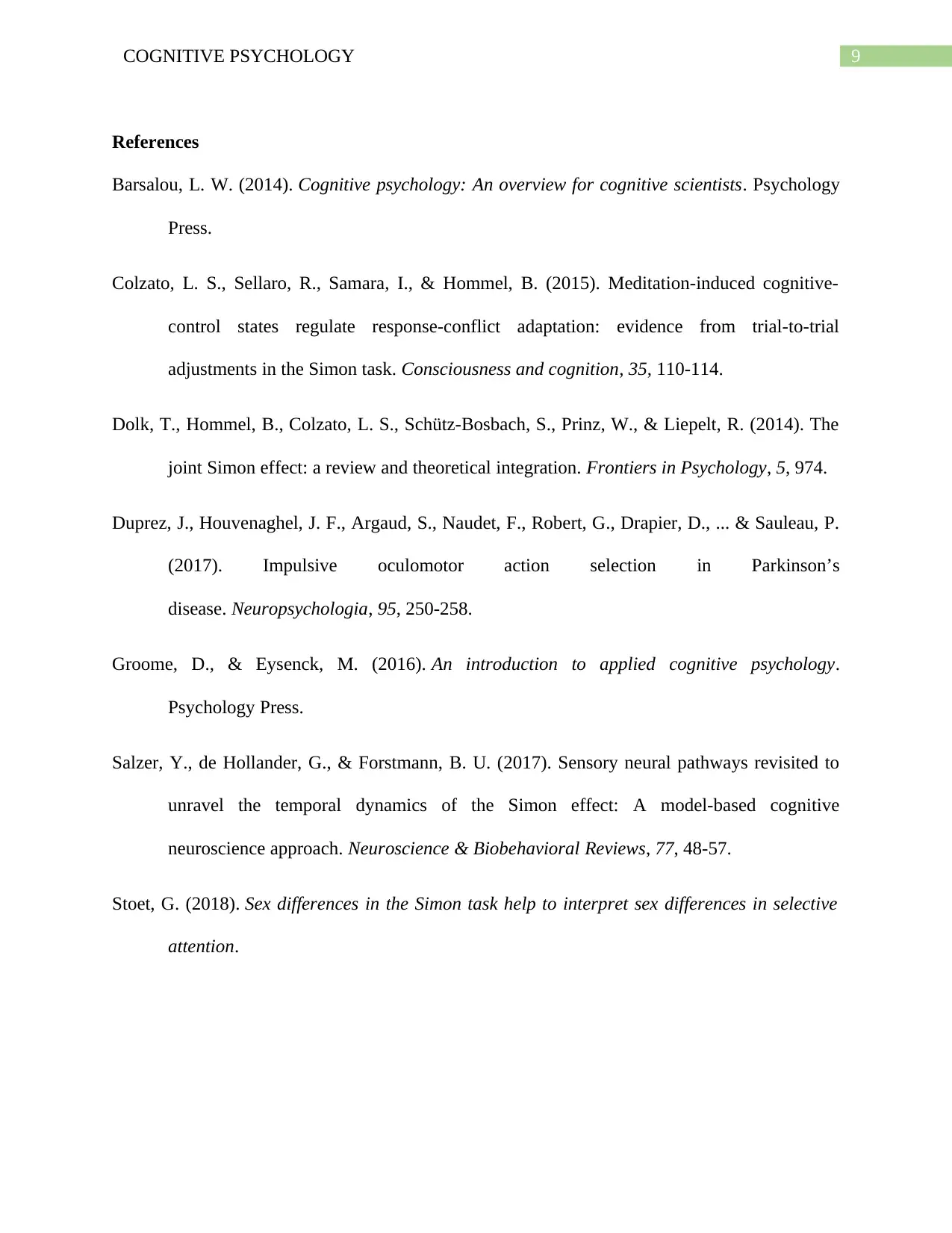
9COGNITIVE PSYCHOLOGY
References
Barsalou, L. W. (2014). Cognitive psychology: An overview for cognitive scientists. Psychology
Press.
Colzato, L. S., Sellaro, R., Samara, I., & Hommel, B. (2015). Meditation-induced cognitive-
control states regulate response-conflict adaptation: evidence from trial-to-trial
adjustments in the Simon task. Consciousness and cognition, 35, 110-114.
Dolk, T., Hommel, B., Colzato, L. S., Schütz-Bosbach, S., Prinz, W., & Liepelt, R. (2014). The
joint Simon effect: a review and theoretical integration. Frontiers in Psychology, 5, 974.
Duprez, J., Houvenaghel, J. F., Argaud, S., Naudet, F., Robert, G., Drapier, D., ... & Sauleau, P.
(2017). Impulsive oculomotor action selection in Parkinson’s
disease. Neuropsychologia, 95, 250-258.
Groome, D., & Eysenck, M. (2016). An introduction to applied cognitive psychology.
Psychology Press.
Salzer, Y., de Hollander, G., & Forstmann, B. U. (2017). Sensory neural pathways revisited to
unravel the temporal dynamics of the Simon effect: A model-based cognitive
neuroscience approach. Neuroscience & Biobehavioral Reviews, 77, 48-57.
Stoet, G. (2018). Sex differences in the Simon task help to interpret sex differences in selective
attention.
References
Barsalou, L. W. (2014). Cognitive psychology: An overview for cognitive scientists. Psychology
Press.
Colzato, L. S., Sellaro, R., Samara, I., & Hommel, B. (2015). Meditation-induced cognitive-
control states regulate response-conflict adaptation: evidence from trial-to-trial
adjustments in the Simon task. Consciousness and cognition, 35, 110-114.
Dolk, T., Hommel, B., Colzato, L. S., Schütz-Bosbach, S., Prinz, W., & Liepelt, R. (2014). The
joint Simon effect: a review and theoretical integration. Frontiers in Psychology, 5, 974.
Duprez, J., Houvenaghel, J. F., Argaud, S., Naudet, F., Robert, G., Drapier, D., ... & Sauleau, P.
(2017). Impulsive oculomotor action selection in Parkinson’s
disease. Neuropsychologia, 95, 250-258.
Groome, D., & Eysenck, M. (2016). An introduction to applied cognitive psychology.
Psychology Press.
Salzer, Y., de Hollander, G., & Forstmann, B. U. (2017). Sensory neural pathways revisited to
unravel the temporal dynamics of the Simon effect: A model-based cognitive
neuroscience approach. Neuroscience & Biobehavioral Reviews, 77, 48-57.
Stoet, G. (2018). Sex differences in the Simon task help to interpret sex differences in selective
attention.
Paraphrase This Document
Need a fresh take? Get an instant paraphrase of this document with our AI Paraphraser
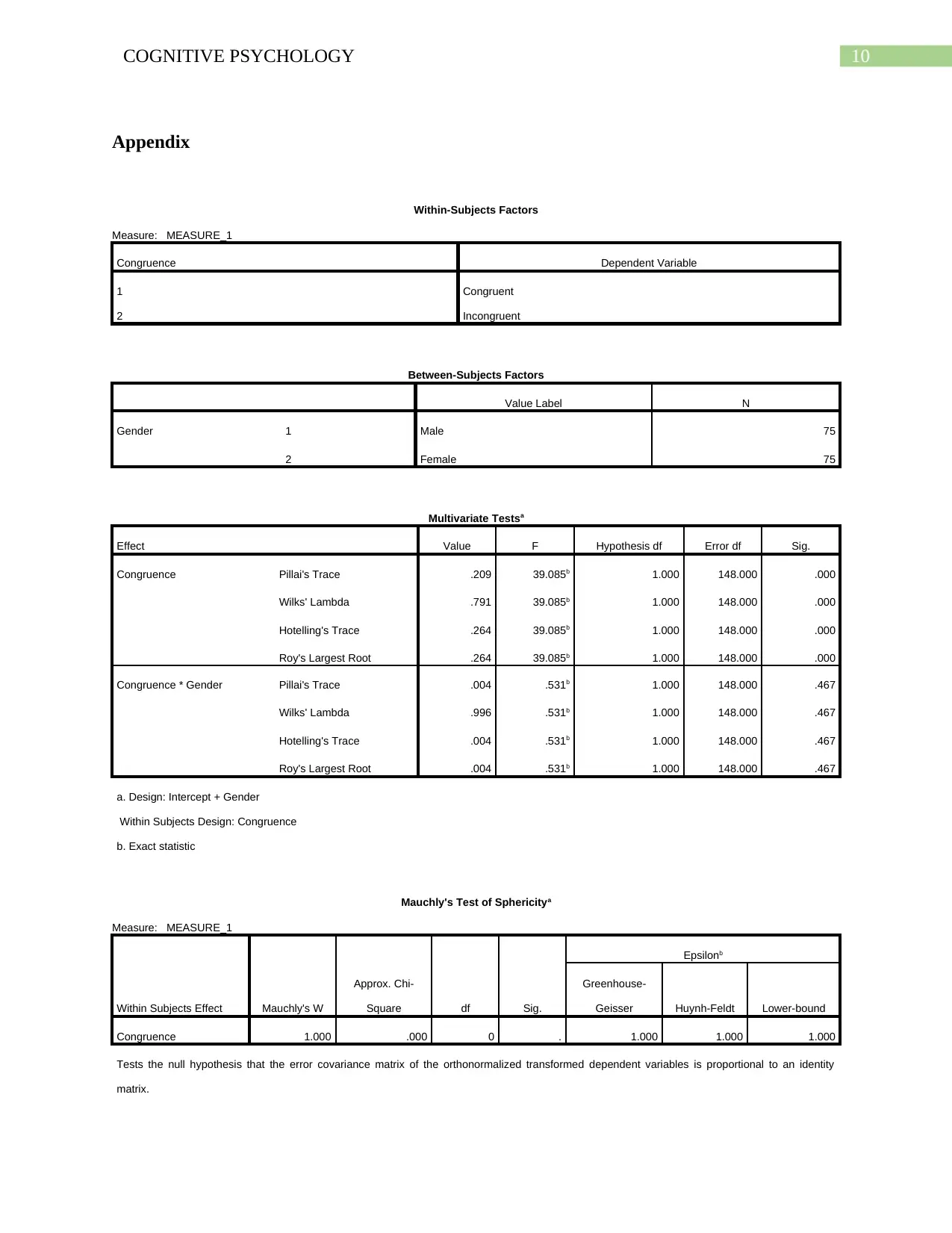
10COGNITIVE PSYCHOLOGY
Appendix
Within-Subjects Factors
Measure: MEASURE_1
Congruence Dependent Variable
1 Congruent
2 Incongruent
Between-Subjects Factors
Value Label N
Gender 1 Male 75
2 Female 75
Multivariate Testsa
Effect Value F Hypothesis df Error df Sig.
Congruence Pillai's Trace .209 39.085b 1.000 148.000 .000
Wilks' Lambda .791 39.085b 1.000 148.000 .000
Hotelling's Trace .264 39.085b 1.000 148.000 .000
Roy's Largest Root .264 39.085b 1.000 148.000 .000
Congruence * Gender Pillai's Trace .004 .531b 1.000 148.000 .467
Wilks' Lambda .996 .531b 1.000 148.000 .467
Hotelling's Trace .004 .531b 1.000 148.000 .467
Roy's Largest Root .004 .531b 1.000 148.000 .467
a. Design: Intercept + Gender
Within Subjects Design: Congruence
b. Exact statistic
Mauchly's Test of Sphericitya
Measure: MEASURE_1
Within Subjects Effect Mauchly's W
Approx. Chi-
Square df Sig.
Epsilonb
Greenhouse-
Geisser Huynh-Feldt Lower-bound
Congruence 1.000 .000 0 . 1.000 1.000 1.000
Tests the null hypothesis that the error covariance matrix of the orthonormalized transformed dependent variables is proportional to an identity
matrix.
Appendix
Within-Subjects Factors
Measure: MEASURE_1
Congruence Dependent Variable
1 Congruent
2 Incongruent
Between-Subjects Factors
Value Label N
Gender 1 Male 75
2 Female 75
Multivariate Testsa
Effect Value F Hypothesis df Error df Sig.
Congruence Pillai's Trace .209 39.085b 1.000 148.000 .000
Wilks' Lambda .791 39.085b 1.000 148.000 .000
Hotelling's Trace .264 39.085b 1.000 148.000 .000
Roy's Largest Root .264 39.085b 1.000 148.000 .000
Congruence * Gender Pillai's Trace .004 .531b 1.000 148.000 .467
Wilks' Lambda .996 .531b 1.000 148.000 .467
Hotelling's Trace .004 .531b 1.000 148.000 .467
Roy's Largest Root .004 .531b 1.000 148.000 .467
a. Design: Intercept + Gender
Within Subjects Design: Congruence
b. Exact statistic
Mauchly's Test of Sphericitya
Measure: MEASURE_1
Within Subjects Effect Mauchly's W
Approx. Chi-
Square df Sig.
Epsilonb
Greenhouse-
Geisser Huynh-Feldt Lower-bound
Congruence 1.000 .000 0 . 1.000 1.000 1.000
Tests the null hypothesis that the error covariance matrix of the orthonormalized transformed dependent variables is proportional to an identity
matrix.
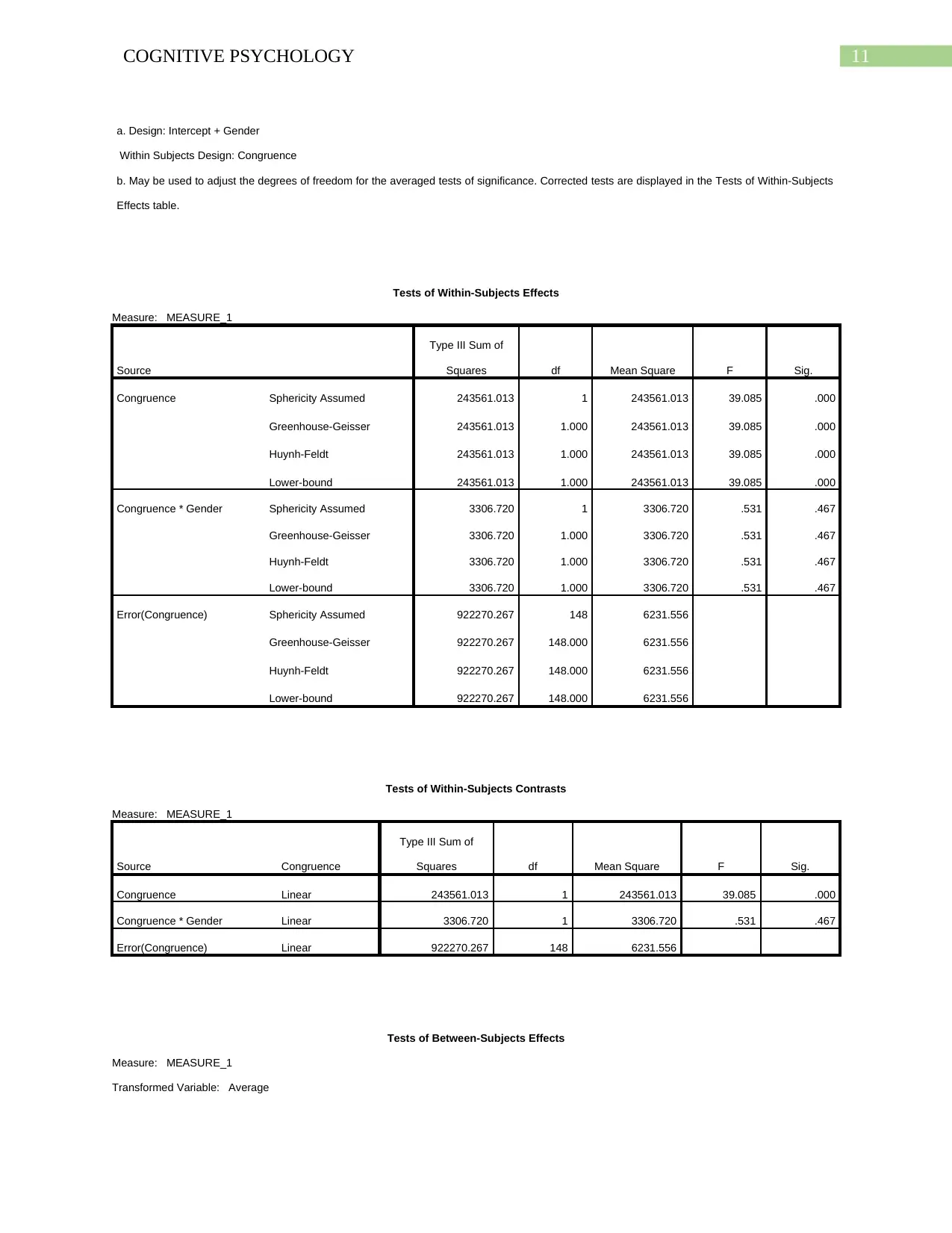
11COGNITIVE PSYCHOLOGY
a. Design: Intercept + Gender
Within Subjects Design: Congruence
b. May be used to adjust the degrees of freedom for the averaged tests of significance. Corrected tests are displayed in the Tests of Within-Subjects
Effects table.
Tests of Within-Subjects Effects
Measure: MEASURE_1
Source
Type III Sum of
Squares df Mean Square F Sig.
Congruence Sphericity Assumed 243561.013 1 243561.013 39.085 .000
Greenhouse-Geisser 243561.013 1.000 243561.013 39.085 .000
Huynh-Feldt 243561.013 1.000 243561.013 39.085 .000
Lower-bound 243561.013 1.000 243561.013 39.085 .000
Congruence * Gender Sphericity Assumed 3306.720 1 3306.720 .531 .467
Greenhouse-Geisser 3306.720 1.000 3306.720 .531 .467
Huynh-Feldt 3306.720 1.000 3306.720 .531 .467
Lower-bound 3306.720 1.000 3306.720 .531 .467
Error(Congruence) Sphericity Assumed 922270.267 148 6231.556
Greenhouse-Geisser 922270.267 148.000 6231.556
Huynh-Feldt 922270.267 148.000 6231.556
Lower-bound 922270.267 148.000 6231.556
Tests of Within-Subjects Contrasts
Measure: MEASURE_1
Source Congruence
Type III Sum of
Squares df Mean Square F Sig.
Congruence Linear 243561.013 1 243561.013 39.085 .000
Congruence * Gender Linear 3306.720 1 3306.720 .531 .467
Error(Congruence) Linear 922270.267 148 6231.556
Tests of Between-Subjects Effects
Measure: MEASURE_1
Transformed Variable: Average
a. Design: Intercept + Gender
Within Subjects Design: Congruence
b. May be used to adjust the degrees of freedom for the averaged tests of significance. Corrected tests are displayed in the Tests of Within-Subjects
Effects table.
Tests of Within-Subjects Effects
Measure: MEASURE_1
Source
Type III Sum of
Squares df Mean Square F Sig.
Congruence Sphericity Assumed 243561.013 1 243561.013 39.085 .000
Greenhouse-Geisser 243561.013 1.000 243561.013 39.085 .000
Huynh-Feldt 243561.013 1.000 243561.013 39.085 .000
Lower-bound 243561.013 1.000 243561.013 39.085 .000
Congruence * Gender Sphericity Assumed 3306.720 1 3306.720 .531 .467
Greenhouse-Geisser 3306.720 1.000 3306.720 .531 .467
Huynh-Feldt 3306.720 1.000 3306.720 .531 .467
Lower-bound 3306.720 1.000 3306.720 .531 .467
Error(Congruence) Sphericity Assumed 922270.267 148 6231.556
Greenhouse-Geisser 922270.267 148.000 6231.556
Huynh-Feldt 922270.267 148.000 6231.556
Lower-bound 922270.267 148.000 6231.556
Tests of Within-Subjects Contrasts
Measure: MEASURE_1
Source Congruence
Type III Sum of
Squares df Mean Square F Sig.
Congruence Linear 243561.013 1 243561.013 39.085 .000
Congruence * Gender Linear 3306.720 1 3306.720 .531 .467
Error(Congruence) Linear 922270.267 148 6231.556
Tests of Between-Subjects Effects
Measure: MEASURE_1
Transformed Variable: Average
⊘ This is a preview!⊘
Do you want full access?
Subscribe today to unlock all pages.

Trusted by 1+ million students worldwide
1 out of 15
Related Documents
Your All-in-One AI-Powered Toolkit for Academic Success.
+13062052269
info@desklib.com
Available 24*7 on WhatsApp / Email
![[object Object]](/_next/static/media/star-bottom.7253800d.svg)
Unlock your academic potential
Copyright © 2020–2025 A2Z Services. All Rights Reserved. Developed and managed by ZUCOL.



